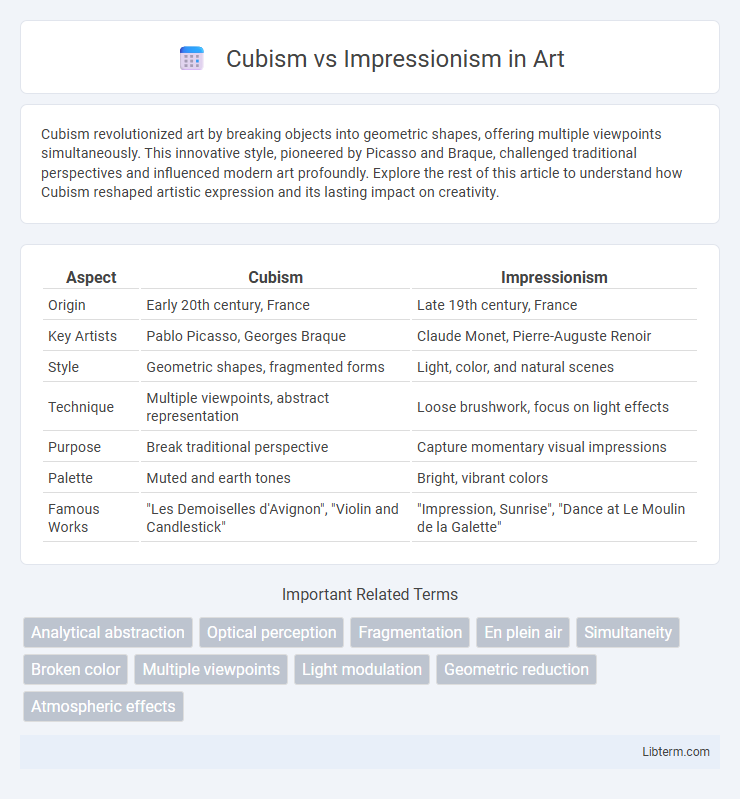Cubism revolutionized art by breaking objects into geometric shapes, offering multiple viewpoints simultaneously. This innovative style, pioneered by Picasso and Braque, challenged traditional perspectives and influenced modern art profoundly. Explore the rest of this article to understand how Cubism reshaped artistic expression and its lasting impact on creativity.
Table of Comparison
| Aspect | Cubism | Impressionism |
|---|---|---|
| Origin | Early 20th century, France | Late 19th century, France |
| Key Artists | Pablo Picasso, Georges Braque | Claude Monet, Pierre-Auguste Renoir |
| Style | Geometric shapes, fragmented forms | Light, color, and natural scenes |
| Technique | Multiple viewpoints, abstract representation | Loose brushwork, focus on light effects |
| Purpose | Break traditional perspective | Capture momentary visual impressions |
| Palette | Muted and earth tones | Bright, vibrant colors |
| Famous Works | "Les Demoiselles d'Avignon", "Violin and Candlestick" | "Impression, Sunrise", "Dance at Le Moulin de la Galette" |
Introduction to Cubism and Impressionism
Cubism and Impressionism are pivotal art movements that redefined visual expression in the late 19th and early 20th centuries. Cubism, pioneered by Pablo Picasso and Georges Braque, emphasizes fragmented subjects and multiple viewpoints to depict objects in a more abstract, geometric form. Impressionism, led by Claude Monet and Pierre-Auguste Renoir, focuses on capturing light and natural scenes with loose brushwork and vibrant color to convey momentary effects and sensory impressions.
Historical Context and Origins
Cubism emerged in the early 20th century, pioneered by Pablo Picasso and Georges Braque in Paris, as a radical departure from traditional perspectives, emphasizing geometric forms and multiple viewpoints. Impressionism originated in the late 19th century France, led by artists such as Claude Monet and Pierre-Auguste Renoir, focusing on capturing light and moments through loose brushwork and vibrant colors. Both movements responded to changing societal and technological landscapes, with Impressionism reacting to industrialization's effects on daily life and Cubism challenging classical representation amid rapid modernization.
Key Artists and Influences
Pablo Picasso and Georges Braque pioneered Cubism by breaking subjects into geometric shapes, influenced by Paul Cezanne's emphasis on structural form. Impressionism featured key artists like Claude Monet and Edgar Degas, who concentrated on fleeting light effects and natural scenes, inspired by the invention of photography and advances in optics. Cubism's analytical approach contrasts with Impressionism's emphasis on capturing immediate sensory impressions.
Core Philosophies and Aesthetic Goals
Cubism emphasizes fragmented perspectives and geometric abstraction to depict multiple viewpoints simultaneously, challenging traditional representation and aiming to reveal the complexity of perception. Impressionism focuses on capturing fleeting moments of light and atmosphere through loose brushwork and vibrant colors, prioritizing sensory experience and the passage of time. Both movements revolutionized visual art by redefining form and perception, with Cubism exploring intellectual deconstruction and Impressionism celebrating immediate visual impression.
Techniques and Artistic Methods
Cubism employs fragmented geometric shapes and multiple perspectives to depict subjects, emphasizing abstraction and deconstruction of form, whereas Impressionism focuses on capturing light and color through loose brushwork and visible strokes to convey atmosphere and momentary impressions. Cubist artists like Picasso and Braque used collage and monochromatic palettes to challenge traditional representation, contrasting with Impressionists such as Monet and Renoir who applied vibrant colors and rapid, layered brush strokes to portray natural scenes. The analytical approach of Cubism breaks objects into planes, while Impressionism's technique prioritizes natural light effects and spontaneity in visual perception.
Color, Light, and Composition Approaches
Cubism employs fragmented, geometric shapes and multiple perspectives to depict subjects, using a restricted, often muted color palette to emphasize form and structure over light effects. Impressionism focuses on capturing natural light and its changing qualities through vibrant, translucent colors applied with loose, dynamic brushstrokes. Compositionally, Cubism breaks down objects into abstract planes to explore spatial relationships, while Impressionism arranges scenes to convey fleeting moments and atmospheric conditions.
Representation of Subjects and Space
Cubism deconstructs subjects into geometric shapes and multiple viewpoints, challenging traditional perspective and emphasizing abstract spatial relationships. Impressionism captures fleeting light and color effects, rendering subjects with loose brushstrokes that suggest movement and atmosphere within a realistic space. The contrast lies in Cubism's analytical fragmentation of form versus Impressionism's focus on perceptual experience and transient visual impressions.
Impact on Modern Art Movements
Cubism revolutionized modern art by introducing fragmented perspectives and abstract forms, influencing movements like Futurism, Constructivism, and Abstract Expressionism. Impressionism, with its emphasis on light and color, paved the way for modern perceptions of naturalism and spontaneity, impacting Fauvism and Post-Impressionism. Both movements collectively expanded the boundaries of artistic expression, shaping the trajectory of 20th-century art.
Notable Works: Cubism vs Impressionism
Notable works in Cubism include Pablo Picasso's "Les Demoiselles d'Avignon" and Georges Braque's "Violin and Candlestick," which exemplify fragmented forms and multiple perspectives. Impressionism is best represented by Claude Monet's "Impression, Sunrise" and Pierre-Auguste Renoir's "Dance at Le Moulin de la Galette," showcasing light effects and everyday scenes with loose brushwork. These masterpieces highlight Cubism's focus on abstract geometry versus Impressionism's emphasis on light and naturalism.
Legacy and Continued Influence
Cubism revolutionized modern art by challenging traditional perspectives and emphasizing geometric abstraction, profoundly influencing 20th-century movements like Futurism and Abstract Expressionism. Impressionism's legacy lies in its capture of light and color, shaping contemporary landscape and portrait painting while inspiring artists to explore perception and atmosphere. Museums worldwide showcase masterpieces from both movements, underscoring their enduring impact on art education and visual culture.
Cubism Infographic

 libterm.com
libterm.com